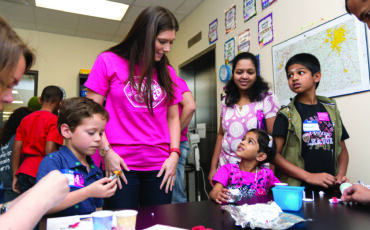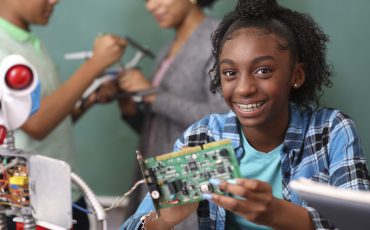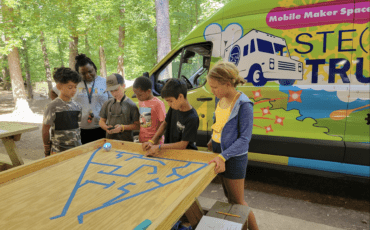STEAM in Schools
“Why is the sky blue?” “How does the car work?” “Why is 4×3 the same as 3×4?”
If your kid is constantly asking questions like these, take a deep breath, and answer as many as you can. For the ones you feel ill-equipped to answers, do some research together and figure it out. Why?
“Because kids are ‘natural scientists,’ they are curious about the world and how things work,” said Evangeline Ricks Agbogu, the Director of Science Akadémeia, a science preschool offering a full-day, year-round program for children ages 2-6. “And, most importantly, 90% of a child’s brain is developing from 0-5 years old. Parents should be the facilitator as children explore their environment, eliciting responses from them by asking open-ended questions.”
It’s not just at home or preschool where asking questions and problem solving should be the focus. Elementary, middle and high schools play a huge role in this endeavor, which is typically addressed as STEAM education. Not only does STEAM relate to students’ natural tendencies and the world around us, but it also prepares them for the future as many of the top careers of today and tomorrow are STEAM-related.
Hands-On Learning
At STEM-Certified Amana Academy, a charter school, students in Kindergarten through 8th grade work through case studies to apply STEAM concepts. “Students come up with the products to address the problems they’re trying to solve in the case studies,” said Yerisson Cardenas, the STEM Director. “Regardless of the subject, we also try to have teachers incorporate STEM in classes. In general, STEM allows students to have more of a hands-on approach to solving problems.”
Embracing a hands-on and engaging approach to science is integral to learning at The Walker School in Marietta. “Whether it’s our Lower School students cracking open and classifying geodes on the playground as a culmination of learning about rocks and minerals, Middle School students baking bread and making cheese to demonstrate their understanding of fermentation or Upper School students sequencing environmental bacteria to improve public health, it is vital to us that learners experience the spark of joyful discovery that deepens into an appreciation and understanding of the interconnected and fascinating natural world around us,” said Emily Adams, the Science Department Chair and Innovative Teaching Chair.
At Clark Creek Elementary STEM Academy, the first school in Cherokee County to receive AdvancEd STEM certification, the Engineering Design Process is central to students learning. The steps of ask, investigate, imagine, plan, create, experiment, improve and present are embedded into the school’s curriculum. “Within each component, students learn a specific skill set as they explore content, and work through social issues or personal situations,” said Principal Joey Moss. “Our students are empowered to use this tool, this way of thinking, for everything they do.”
Real-World Applications
The concepts found within STEAM can help students develop their critical thinking, communication and problem-solving skills, which they can use in everyday life.
“STEAM education is important for multiple reasons,” said Angie Wood, the Magnet Coordinator at Kennesaw Mountain High School’s Academy of Mathematics, Science, and Technology. “It allows students to apply their content learning to real-world applications. This application provides meaning to learning or helps to answer, ‘When will we ever use this?’ But most importantly, it provides skills applicable to jobs that don’t yet exist, giving students the flexibility to follow their career interests as they develop throughout their lifetime.”
Adams agreed. “STEAM education is necessary to best equip students for the increasingly complex and technological world they are living in now and will grow up into. It allows learners to build a toolkit of skills, like being able to approach issues with questions, logic and creativity. By giving our students consistent hands-on experience with maker activities and authentic tools and equipment, they develop a deep understanding of the ‘how’ and ‘why’ of modern science and technology, confidence in using those tools and the ability to apply those skills to a wide variety of situations. STEAM also inspires collaboration between students with unique talents and passions to bring their own lens to the communal discovery process. This naturally builds the ability to communicate clearly and technically, a skill they will use for the rest of their lives.”
Future-Focused Skills
An advantage of STEAM education with a longer road to seeing results is preparation for the future. Career paths are rapidly changing and growing, especially in STEAM-related fields.
“STEM careers are the most lucrative and abundant in the world right now and will be for some time,” Moss said. “It’s not enough for students to get this exposure in high school or even middle school. We lay the foundation for students who want to enter these career fields. We open their eyes to new ideas and new passions.”
At the Academy of Mathematics, Science, and Technology at Kennesaw Mountain High School, seniors are required to complete a capstone project that includes field experience or an internship with a local institution of higher learning, professional group or business. “Whenever I speak with business leaders and employers about the characteristics of any employee, they almost always look for critical thinkers and team players. Even if students pursue STEAM coursework and choose a career that doesn’t have a STEAM focus, they will walk away with critical thinking and problem- solving skills,” Wood said. “The problem-solving skills they learn will apply to all aspects of their life, not just their careers.”











